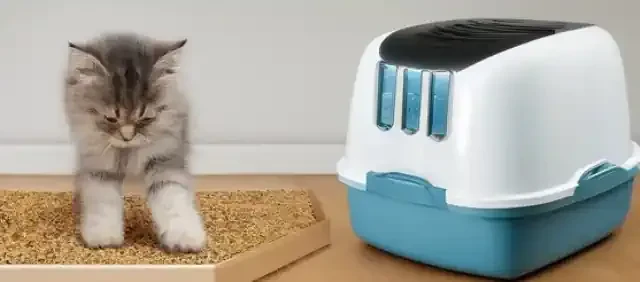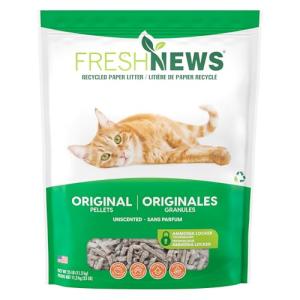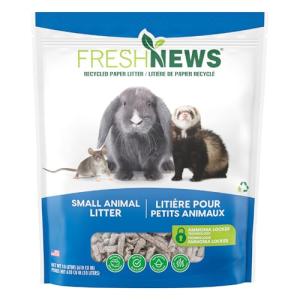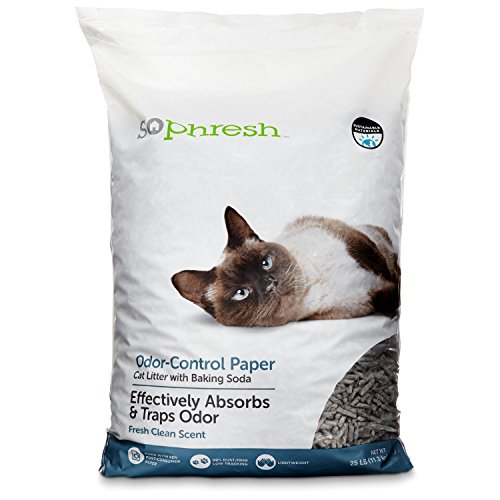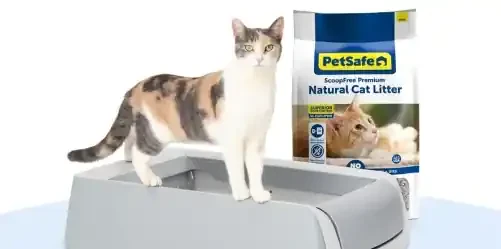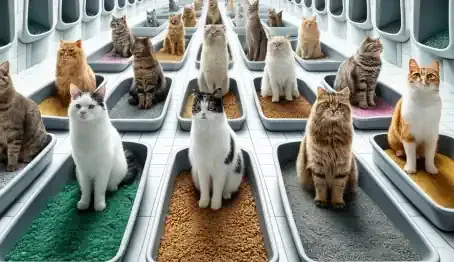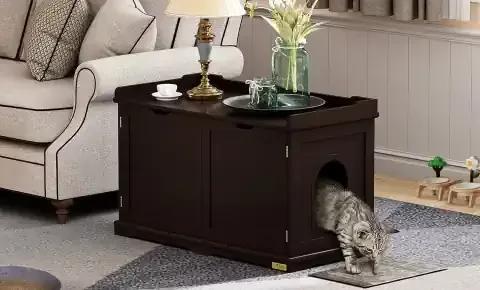Understanding the Importance of Cat Litter
Cat litter plays a crucial role in maintaining the health and hygiene of our feline companions. Beyond serving as a spot for them to relieve themselves, cat litter also aids in controlling odors and providing comfort for cats while they attend to their natural instincts. Understanding the significance of cat litter goes beyond its utilitarian purpose; it directly impacts the well-being of our pets and the harmony within our homes.
Overview of the Article's Content
In this comprehensive guide, we'll delve into the intricate world of cat litter selection, exploring various factors that every cat owner should consider when choosing the right litter for their furry friends. From the different types of litter materials to the environmental impact and health considerations, we aim to provide you with all the information needed to make an informed decision. Whether you're a seasoned cat owner or a novice feline enthusiast, this article will equip you with the knowledge to navigate the vast array of cat litter options available on the market.
Why Choosing the Right Cat Litter Matters
Selecting the appropriate cat litter is not a decision to be taken lightly. Beyond the obvious benefits of maintaining a clean and odor-free environment, the right cat litter can contribute to your cat's overall health and well-being. Factors such as litter material, odor control features, and even environmental impact can have a significant impact on your cat's comfort and happiness. By understanding why choosing the right cat litter matters, you can prioritize your cat's needs while ensuring a harmonious living space for both you and your pet.
Consideration Factors
Type of Cat Litter Material
When it comes to selecting cat litter, one of the most fundamental decisions is the type of material used. Each type of litter material has its own set of characteristics and benefits, catering to different preferences and needs.
Clumping vs. Non-Clumping
Clumping litter, typically made from bentonite clay or silica gel, forms tight clumps when in contact with moisture, making it easier to scoop and clean. This type of litter is favored by many cat owners for its convenience and superior odor control. On the other hand, non-clumping litter, often composed of natural materials like wood, paper, or plant-based substances, does not form clumps but instead absorbs moisture, reducing the risk of tracking and offering a more natural feel for cats.
Silica Gel vs. Clay
Silica gel litter, also known as crystal litter, is made from silica sand infused with moisture-absorbing crystals. It's highly absorbent and effective at controlling odors, making it a popular choice for busy cat owners. Clay litter, on the other hand, is derived from natural clay minerals and is known for its excellent clumping ability and odor control properties. Both types of litter have their merits, and the choice between them often comes down to personal preference and the specific needs of your cat.
Natural vs. Synthetic
Natural cat litters are made from renewable, biodegradable materials such as corn, wheat, pine, or recycled paper. These litters are eco-friendly and often preferred by environmentally conscious cat owners. Synthetic litters, on the other hand, are typically made from clay or silica gel and may contain additives or fragrances for enhanced odor control. While synthetic litters may offer superior performance in some cases, natural litters appeal to those seeking a more sustainable and natural alternative for their pets.
Odor Control Features
Maintaining a fresh-smelling home is a top priority for many cat owners, making odor control a critical consideration when choosing cat litter. Several features and additives are available to help combat litter box odors and keep your home smelling clean and pleasant.
Scented vs. Unscented Options
Scented cat litters are infused with fragrances or deodorizers designed to mask litter box odors and provide a fresh scent. While some cats may find scented litters appealing, others may be sensitive to artificial fragrances, leading to aversion or allergic reactions. Unscented litters, on the other hand, contain no added fragrances and are preferred by many cat owners for their neutral odor profile. When selecting a scented or unscented litter, consider your cat's preferences and any sensitivities they may have.
Activated Carbon Technology
Many cat litters feature activated carbon, a highly porous substance that effectively absorbs and traps odorous molecules, neutralizing unpleasant smells. Activated carbon technology is commonly used in both clumping and non-clumping litters to enhance odor control and keep litter boxes fresh for longer periods between cleanings. Look for litters labeled with activated carbon or odor-absorbing properties for maximum odor control effectiveness.
Bacterial Growth Prevention
Some cat litters are formulated with antimicrobial agents or additives designed to inhibit the growth of odor-causing bacteria in the litter box. By preventing bacterial proliferation, these litters help reduce the formation of ammonia and other malodorous compounds, resulting in a cleaner and more hygienic litter box environment. When evaluating litter options, consider choosing a product with bacterial growth prevention features to maintain optimal litter box hygiene and odor control.
Dust Levels and Allergen Control
Dust and allergens present in cat litter can pose health risks for both cats and their owners, making dust levels and allergen control important factors to consider when selecting cat litter.
Low-Dust Formulas
Dusty cat litters can exacerbate respiratory issues in cats and contribute to respiratory discomfort for humans, particularly those with allergies or asthma. Low-dust cat litters are formulated to minimize airborne dust particles, reducing the risk of respiratory irritation and allergic reactions. Look for litters labeled as low-dust or dust-free to provide a cleaner and healthier litter box environment for you and your cat.
Hypoallergenic Options
For cats and humans with sensitivities to dust and allergens, hypoallergenic cat litters offer a gentler alternative that minimizes the risk of allergic reactions. These litters are typically made from natural, non-toxic materials and undergo rigorous testing to ensure they are safe for sensitive individuals. When choosing cat litter, consider opting for a hypoallergenic formula to provide relief for allergy-prone pets and their owners.
Respiratory Health Concerns
Chronic exposure to dust and airborne particles from cat litter can contribute to respiratory issues such as coughing, wheezing, and difficulty breathing in both cats and humans. To mitigate these health concerns, select cat litters with low-dust formulas and consider using a dust-free litter box or enclosed litter box system to contain airborne particles. Additionally, regularly cleaning and maintaining the litter box area can help minimize dust accumulation and promote better respiratory health for you and your cat.
Cat Preference and Behavior
Understanding your cat's preferences and behavior is essential when selecting the right cat litter. Cats can be quite particular about their litter box experience, and factors such as texture, privacy, and the presence of other cats can influence their litter box habits.
Texture and Granule Size
The texture and granule size of cat litter can significantly impact your cat's comfort and satisfaction with their litter box. Cats have sensitive paw pads, so finding a litter with a texture that they find comfortable to walk on is crucial for encouraging regular litter box use.
Fine vs. Coarse Granules
Some cats prefer finer litter granules, which feel soft and gentle on their paws. Fine-grain litters tend to clump well and offer excellent absorption, making them easier to clean and maintain. However, other cats may prefer coarser granules, which provide more traction and resemble the feel of natural substrates like sand or soil. Experiment with different granule sizes to determine which texture your cat prefers.
Soft vs. Hard Texture
In addition to granule size, the overall texture of the litter can influence your cat's litter box preferences. Soft-textured litters, such as those made from recycled paper or plant-based materials, offer a comfortable surface for cats to dig and bury their waste. Conversely, some cats may prefer litter with a harder texture, such as clay-based litters, which provide more resistance and stability for digging. Consider your cat's preferences and behavior when selecting a litter with the appropriate texture for their comfort.
Enclosed vs. Open Litter Box
The type of litter box you choose can have a significant impact on your cat's privacy and sense of security while using the litter box. Enclosed litter boxes provide a secluded space for cats to do their business, while open litter boxes offer easy access and visibility.
Privacy Preferences of Cats
Many cats prefer privacy when using the litter box, as it mimics the feeling of safety and security they would experience while eliminating in the wild. Enclosed litter boxes, with their covered design and entrance openings, offer cats a secluded space to do their business away from prying eyes and potential disturbances. If your cat is shy or easily startled, an enclosed litter box may provide the privacy they crave.
Accessibility for Older or Disabled Cats
While enclosed litter boxes offer privacy, they may not be suitable for all cats, especially those with mobility issues or seniors with arthritis. Open litter boxes, with their low sides and easy access, are often preferred by older or disabled cats who may struggle to climb in and out of enclosed boxes. When selecting a litter box, consider your cat's age, mobility, and any special needs they may have to ensure they can comfortably access and use the litter box.
Multi-Cat Household Considerations
If you share your home with multiple cats, understanding their dynamics and preferences is essential for maintaining harmony and minimizing litter box issues. Cats are territorial animals, and conflicts over litter box access and resources can arise in multi-cat households.
Compatibility with Multiple Cats
When choosing cat litter for a multi-cat household, consider the preferences and habits of each cat to ensure they are all comfortable using the litter box. Some cats may prefer different litter textures or types, so providing a variety of litter options can help accommodate their individual needs. Additionally, ensure there are enough litter boxes available to prevent overcrowding and territorial disputes.
Managing Territorial Behavior
Cats may exhibit territorial behavior around the litter box, especially in multi-cat households where resources are shared. To minimize conflicts, place litter boxes in quiet, low-traffic areas of the home where cats can use them without feeling threatened or interrupted by other pets. Additionally, scoop litter boxes regularly to prevent waste buildup and maintain a clean, inviting environment for all cats. Providing separate litter boxes for each cat can also help reduce territorial issues and promote litter box harmony in multi-cat households.
Environmental Impact
Considering the environmental impact of cat litter is becoming increasingly important for conscientious pet owners. From the sourcing of materials to the disposal of used litter, every aspect of the cat litter lifecycle can have environmental implications. Here, we explore various factors to consider when selecting cat litter with sustainability in mind.
Biodegradable and Eco-Friendly Options
As awareness of environmental issues grows, demand for biodegradable and eco-friendly cat litter options has increased. These litters are made from renewable, compostable, or recycled materials and are designed to break down naturally over time, minimizing their impact on the environment.
Sustainable Material Sourcing
Look for cat litters made from sustainably sourced materials such as corn, wheat, bamboo, or recycled paper. These materials are renewable resources that can be replenished over time, reducing reliance on finite resources and minimizing environmental degradation. Choosing cat litter made from sustainably sourced materials helps support eco-friendly practices and reduces your carbon footprint.
Compostable Litter
Compostable cat litters are designed to decompose in a composting environment, breaking down into organic matter that can be safely returned to the soil. These litters are typically free from synthetic additives and chemicals, making them safe for use in garden compost bins or municipal composting facilities. When composting cat litter, be sure to follow proper composting guidelines and avoid composting waste from sick cats or cats treated with medication.
Carbon Footprint and Manufacturing Process
The manufacturing process of cat litter can have significant environmental implications, including energy consumption, greenhouse gas emissions, and waste generation. Choosing cat litters produced using environmentally friendly manufacturing practices can help reduce your carbon footprint and minimize environmental harm.
Energy Efficiency
Look for cat litter manufacturers that prioritize energy efficiency and sustainability in their production processes. Companies that use renewable energy sources, implement energy-saving technologies, and minimize waste generation can significantly reduce their environmental impact. By supporting these eco-conscious brands, you can contribute to a more sustainable future for both pets and the planet.
Packaging Materials
Consider the packaging materials used for cat litter products, as excessive packaging can contribute to waste generation and environmental pollution. Look for litters packaged in eco-friendly materials such as recycled paper, cardboard, or biodegradable plastics. Additionally, choose products with minimal packaging or packaging that can be recycled or reused to further reduce waste.
Disposal Methods and Waste Management
Proper disposal of used cat litter is essential for minimizing environmental contamination and protecting human and animal health. Understanding the various disposal methods available and their environmental implications can help you make informed choices about managing cat litter waste.
Landfill vs. Flushable Options
Traditional clay-based cat litters are typically disposed of in landfills, where they contribute to waste accumulation and environmental pollution. Alternatively, some cat litters are flushable, allowing you to dispose of waste down the toilet for convenient and environmentally friendly disposal. However, not all cat litters are suitable for flushing, so be sure to check the packaging and follow manufacturer recommendations.
Recycling Possibilities
Some cat litters are made from recycled materials or are themselves recyclable, offering opportunities for waste reduction and resource conservation. Look for cat litters made from recycled paper, cardboard, or other recyclable materials, and be sure to dispose of used litter in accordance with local recycling guidelines. Additionally, consider repurposing empty litter containers for storage or DIY projects to further reduce waste and promote sustainability.
Budget and Cost Considerations
Managing your budget while providing the best care for your cat is essential for many pet owners. When it comes to cat litter, there is a wide range of options available at various price points. Understanding the cost factors associated with different types of cat litter can help you make informed decisions that balance quality with affordability.
Price Range of Different Cat Litter Types
Cat litter prices can vary significantly depending on factors such as the type of litter material, brand reputation, and additional features or additives. Here's an overview of the typical price ranges for different types of cat litter:
Budget-Friendly Options
Traditional clay-based cat litters are often the most budget-friendly option, with prices ranging from a few dollars to around $20 per 20-pound bag. These litters offer basic odor control and absorption properties at an affordable price point, making them suitable for cat owners on a tight budget.
Premium and High-End Brands
Premium cat litters, such as clumping litters made from natural or silica gel materials, tend to be more expensive, with prices ranging from $20 to $50 or more per bag. These litters often offer superior odor control, dust reduction, and longevity compared to budget options, making them worth the investment for some cat owners.
Cost-Effectiveness Over Time
When evaluating the cost of cat litter, it's essential to consider its cost-effectiveness over time. While budget-friendly options may have a lower upfront cost, they may need to be replaced more frequently or require larger quantities to achieve the same level of performance as premium litters.
Longevity and Durability
Premium cat litters are often more concentrated and absorbent than budget options, allowing them to last longer between litter box cleanings. While the upfront cost may be higher, the extended lifespan of premium litters can result in cost savings over time by reducing the frequency of litter replacement.
Frequency of Replacement
Consider how often you need to replace the cat litter to maintain a clean and odor-free litter box environment. While budget-friendly litters may be cheaper upfront, they may require more frequent replacement due to inferior odor control or clumping properties. Premium litters, with their superior performance and longevity, may need to be replaced less frequently, offsetting the higher initial cost.
Value for Money Factors
When choosing cat litter, it's essential to consider the overall value for money rather than focusing solely on the upfront cost. Factors such as performance, convenience, and health considerations can all contribute to the value proposition of a cat litter product.
Balancing Quality and Price
Striking a balance between quality and price is key to finding the best value cat litter for your budget. While it's tempting to opt for the cheapest option available, investing in a higher-quality litter with superior performance and health benefits may ultimately save you money in the long run by reducing litter usage, minimizing waste, and promoting your cat's well-being.
Bulk Buying and Subscription Services
Some cat litter brands offer discounts for purchasing in bulk or subscribing to regular deliveries. By buying in larger quantities or signing up for a subscription service, you can save money on cat litter while ensuring you always have an ample supply on hand. Additionally, subscription services can save you time and hassle by automating the delivery process and ensuring you never run out of litter.
Health and Safety Concerns
Ensuring the health and safety of your cat is paramount when selecting cat litter. From avoiding harmful chemicals to minimizing respiratory irritants, there are several factors to consider to promote your cat's well-being while maintaining a clean and hygienic litter box environment.
Non-Toxic Ingredients and Chemicals
Choosing cat litter made from non-toxic materials is essential for safeguarding your cat's health and minimizing the risk of exposure to harmful chemicals. Be mindful of potential additives and chemicals commonly found in cat litter and opt for products that prioritize safety and transparency.
Potential Harmful Additives
Some cat litters may contain additives such as artificial fragrances, dyes, or chemical deodorizers that can be harmful to cats, especially those with sensitivities or allergies. These additives can irritate your cat's skin, eyes, or respiratory system, leading to discomfort or adverse health effects. When selecting cat litter, opt for products labeled as free from artificial additives and fragrances to minimize the risk of exposure to harmful chemicals.
Safety Standards and Regulations
Look for cat litter products that adhere to safety standards and regulations established by reputable organizations or regulatory bodies. Products that have been tested for safety and certified by independent organizations can provide peace of mind knowing they meet rigorous quality and safety criteria. Additionally, familiarize yourself with common allergens and irritants found in cat litter and choose products that prioritize safety and transparency in their ingredient list.
Dust and Respiratory Health
Exposure to dust and airborne particles from cat litter can pose respiratory risks for both cats and their owners. Minimizing dust levels and selecting low-dust or dust-free cat litter options can help reduce respiratory irritation and promote better respiratory health for you and your cat.
Risks of Inhalation
Dusty cat litters can contain fine particles that become airborne during use, posing inhalation risks for cats and humans alike. Chronic exposure to airborne dust can irritate the respiratory tract, leading to coughing, sneezing, wheezing, and other respiratory symptoms. To minimize inhalation risks, choose cat litters with low-dust formulas and avoid products that generate excessive dust during use.
Minimizing Exposure for Cats and Owners
To reduce dust exposure for both cats and their owners, place litter boxes in well-ventilated areas away from high-traffic zones. Use dust-free or low-dust cat litter formulas and consider investing in a litter mat or box with a lid to contain airborne particles. Additionally, wear a dust mask or respirator when handling cat litter, especially if you have respiratory sensitivities or allergies.
Allergic Reactions and Sensitivities
Cats, like humans, can develop sensitivities or allergies to certain substances found in cat litter. Recognizing the signs of allergic reactions and choosing hypoallergenic cat litter options can help alleviate discomfort and promote your cat's overall health and well-being.
Identifying and Managing Allergens
Common allergens found in cat litter include dust, fragrance additives, and natural materials such as pine or wheat. If your cat exhibits signs of allergic reactions, such as itching, sneezing, or skin irritation, consider switching to a hypoallergenic cat litter formula made from non-toxic, fragrance-free materials. Additionally, consult with your veterinarian to rule out underlying health issues and determine the best course of action for managing your cat's allergies.
Seeking Veterinary Advice
If you suspect your cat is experiencing allergic reactions or respiratory issues related to cat litter, seek veterinary advice promptly. Your veterinarian can conduct allergy testing to identify specific triggers and recommend appropriate treatment options. In some cases, switching to a hypoallergenic cat litter formula or implementing environmental modifications may be necessary to alleviate symptoms and improve your cat's quality of life.
Reviews and Recommendations
When selecting cat litter, gathering insights from user experiences, expert opinions, and specific recommendations can help you make informed decisions that align with your cat's needs and preferences. Here, we explore various sources of reviews and recommendations to guide your cat litter selection process.
User Experiences and Testimonials
User reviews and testimonials provide valuable insights into the performance, quality, and satisfaction levels associated with different cat litter products. By reading reviews from other cat owners, you can gain valuable firsthand perspectives and learn from their experiences.
Customer Reviews
Online retailers and pet supply stores often feature customer reviews and ratings for cat litter products. Reading through these reviews can provide insights into factors such as clumping ability, odor control, dust levels, and overall satisfaction. Pay attention to recurring themes and patterns in customer feedback to identify common strengths and weaknesses of each litter product.
Expert Opinions
Seek out expert reviews and recommendations from trusted sources such as pet care websites, blogs, and magazines. Experts may conduct in-depth product testing and analysis, providing comprehensive evaluations of cat litter performance, safety, and value. Look for expert reviews that consider factors such as litter composition, odor control effectiveness, environmental impact, and user-friendliness.
Top-Rated Cat Litter Brands
Identifying top-rated cat litter brands can help narrow down your options and focus on products known for their quality, reliability, and customer satisfaction. Consider factors such as brand reputation, product consistency, and customer service when evaluating different brands.
Comparing Popular Choices
Research popular cat litter brands and compare their features, formulations, and customer reviews to determine which products best meet your cat's needs. Look for brands with a track record of producing high-quality, dependable cat litter products and consider trying out samples or smaller quantities before committing to a larger purchase.
Award-Winning Products
Keep an eye out for cat litter products that have received awards or accolades from industry organizations, pet care professionals, or consumer advocacy groups. Award-winning products are often recognized for their innovation, performance, and customer satisfaction, making them worth considering when making your final decision.
Considerations for Specific Cat Breeds
Different cat breeds may have unique litter box preferences and requirements based on factors such as size, coat type, and personality. Tailoring your cat litter selection to your cat's breed-specific needs can help ensure a positive litter box experience for both you and your furry companion.
Tailoring Litter Selection to Breed Needs
Research breed-specific litter box preferences and tendencies to determine which types of litter are best suited to your cat's breed. For example, long-haired breeds may prefer softer, low-dust litter to minimize matting and tangling, while large breeds may require larger litter boxes to accommodate their size. Consider consulting with breed-specific experts or veterinarians for personalized recommendations based on your cat's breed characteristics.
Breed-Specific Recommendations
Some cat litter brands may offer specific formulas or products designed to meet the needs of certain cat breeds. Look for litter products tailored to your cat's breed characteristics, such as hairball control formulas for long-haired breeds or lightweight options for small or elderly cats. Additionally, consider factors such as litter box size, shape, and accessibility when choosing a litter box that accommodates your cat's breed-specific needs.
Conclusion
As we wrap up our exploration of choosing the right cat litter, it's essential to reflect on the key insights gained and the importance of making informed decisions for your feline friend. Here, we summarize the main points discussed and offer some final thoughts on selecting the perfect cat litter for your cat's needs.
Summarizing Key Points
Throughout this guide, we've discussed various factors to consider when choosing cat litter, including litter material, odor control features, cat preferences, environmental impact, budget considerations, and health and safety concerns. By taking into account these factors and prioritizing your cat's well-being, you can make choices that promote a clean, comfortable, and hygienic litter box environment for your furry companion.
Final Thoughts on Choosing the Right Cat Litter
Selecting the right cat litter is a personal decision that depends on your cat's individual preferences, your budget constraints, and your environmental values. While there is no one-size-fits-all solution, understanding your cat's needs and prioritizing factors such as odor control, dust levels, and environmental sustainability can help guide your decision-making process.
Remember to experiment with different litter types and formulations to find the best fit for your cat, and don't hesitate to seek advice from veterinarians, fellow cat owners, and trusted pet care professionals. By staying informed and proactive about your cat's litter box care, you can ensure a positive and stress-free experience for both you and your beloved feline companion.
Encouragement for Further Research and Experimentation
Choosing cat litter is an ongoing process that may require some trial and error to find the perfect match for your cat's needs. Don't be afraid to experiment with different brands, formulas, and litter box setups until you find what works best for your cat. Keep an open mind, stay attuned to your cat's behavior and preferences, and be willing to adapt and make changes as needed.
Additionally, stay informed about new developments and innovations in the cat litter industry, as advancements in litter technology and sustainability practices continue to evolve. By staying proactive and engaged, you can ensure that your cat enjoys a clean, comfortable, and hygienic litter box environment for years to come.
